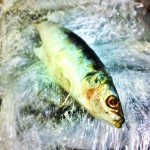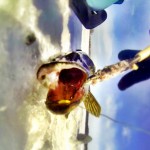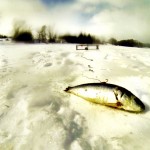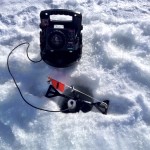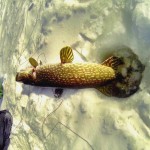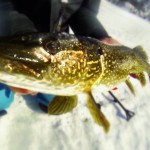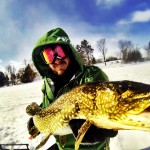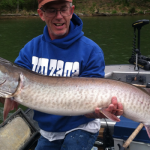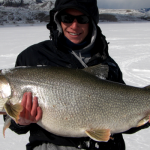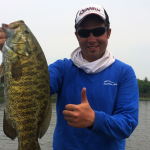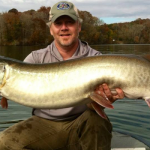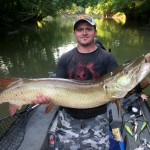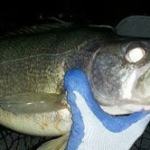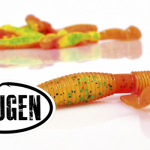By Robert Conley & Robert Fuchs
This has got to be the most anticipated cry on the ice. There is no sweeter sight then a bright orange flag pointing up towards the skies. With winter coming to an end, it’s time for us to put some pressure on our favorite species, big old northern’s. Esox Lucius will begin to pre-spawn and they are desperate for some much needed extra calories.
The weapons of choice when targeting these beasts are clearly a dead stinky bait and a tip up. It is simply the easiest way to present a succulent meal that no predator could ever resist. Tip ups are not just a filler for the second line slot, for us they are the big guns, the ace up the sleeve and we would never venture without them. Perhaps it’s the low tech, the no hustle approach to this simple method that is so appealing or maybe just its endless track record to produce big trophy pike. Welcome to the Tip Up Guide – Big Boy Addiction.
Equipment:
The market is flooded with tip ups and everyone has his own personal preferences, essentially any type will do. Brand or build doesn’t really matter as they all accomplishing the exact same thing. The goal is to have the bait suspended off bottom, preferably a foot or two. The flag is triggered once line gets peeled off the spool, indicating a bite. It is as simple as that. A few ground rules however shall be established. First and foremost, the line.
Standard tip up braid in the 30 lb ranger will work just fine. It’s thicker than regular braid and gives you a good grip when push comes to shove. Don’t be discouraged by the large diameter as pike are not too shy at all. If however clear water or a lot of fishing pressure are present, you can switch to a regular 30 lb instead.
This should fill about 90% of the spool and is your main line. Let’s talk about the business end. A good old swivel connects the braid to a mono leader which should be around 25 -30 lb test and about 3 to 5 feet in lengths.
When we fish super shallow, let’s say crawlspaces with less than 3 feet of water the leader is quite a bit shorter because you don’t want the swivel getting snagged on the spool guide. This could potentially block the line and will result in a lost fish or broken equipment. A second swivel is tied on and a small split shot can be placed above if you are fishing in deeper waters or if a current is present. Next the star of the whole rig, the quick strike.
We can’t stress the importance of this presentation, we catch and release so the fishes well being and health means everything to us. The quick strike usually launches itself right in front of the jar and makes for a fast remove and quick release. Especially in frigged temperatures, sensitive fins and eyes can freeze over within seconds, the less time spend out of water the greater the chances are for a second rendezvous another time. Quick strikes also allow the bait to sit perfectly horizontal which makes for a more natural presentation.
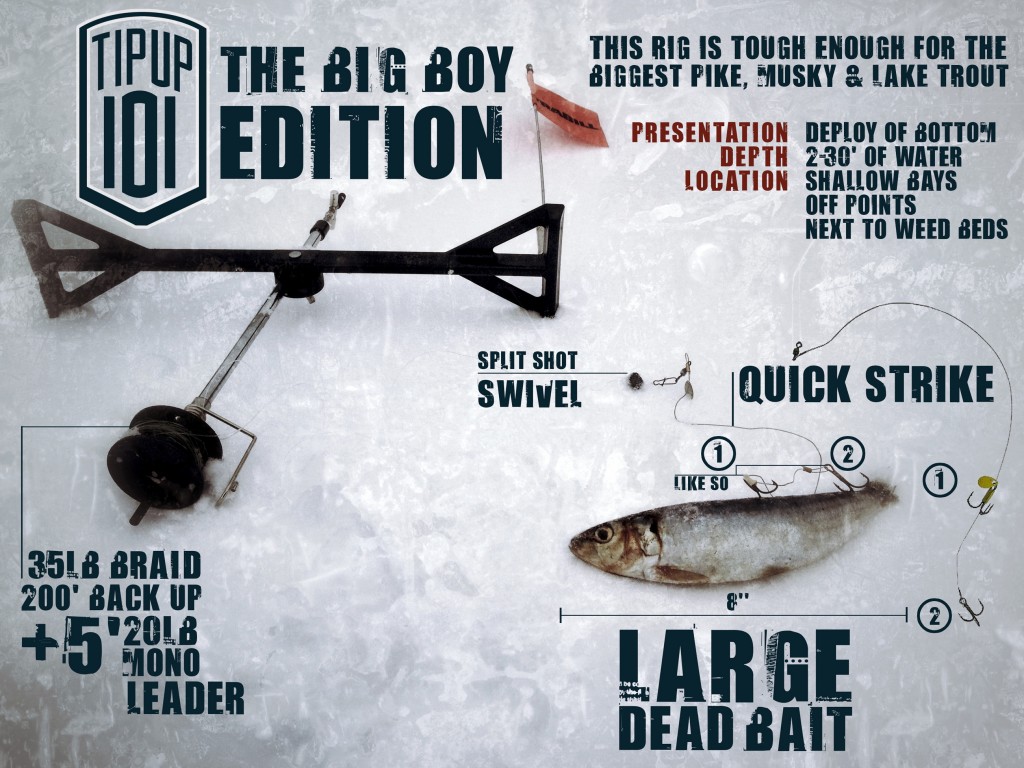
The bait!
We prefer large dead bait and when we say large we mean it.
The weapon of choice for us is frankly quite brilliant. It’s effective and affordable, easy to get a hold of, and easy to store in your freezer for the entire season; Xxl frozen sardines, herrings and mackerels.
Any Asian food store generally sells a dozen for 3 or 4 dollars. Wal Mart has them too and any local fishmonger will be happy to hand you a bunch for next to nothing.
Out of experience, the smellier they are the better they work. We like to take ours out of the freezer a few days before the trip. Let them thaw and get nice and stinky. The natural oils will leave a wicked scent trail that will make your wives angry but draws fish in from a mile away.
Location!
Now we got the bare bones covered, lets find a suitable location to deploy this mean machine. Just because it’s winter, it doesn’t mean the fish will completely 180* change their behavior. Feeding patterns will carry over throughout the year.
With this said use your own knowledge to your advantage and target them toothy critters in the same spots as you would in spring and summer.
Shallow bays, the edges of weed beds, flats with access to drop-offs, and the mouths and inlets of feeder creeks, Pike like to cruise along points and structure, ready to ambush any prey.
Once the perfect location is chosen we like to drill and prepare every hole at once, settling on a few promising spots and committing to them. Make all the noise now and give them some time to settle while you set up camp for the day. On super cold days it pays off to carve a good sized trench and punch a hole at one end so it fills up with water. These are used as makeshift live wells to keep our trophies safe and sound while we handle them.
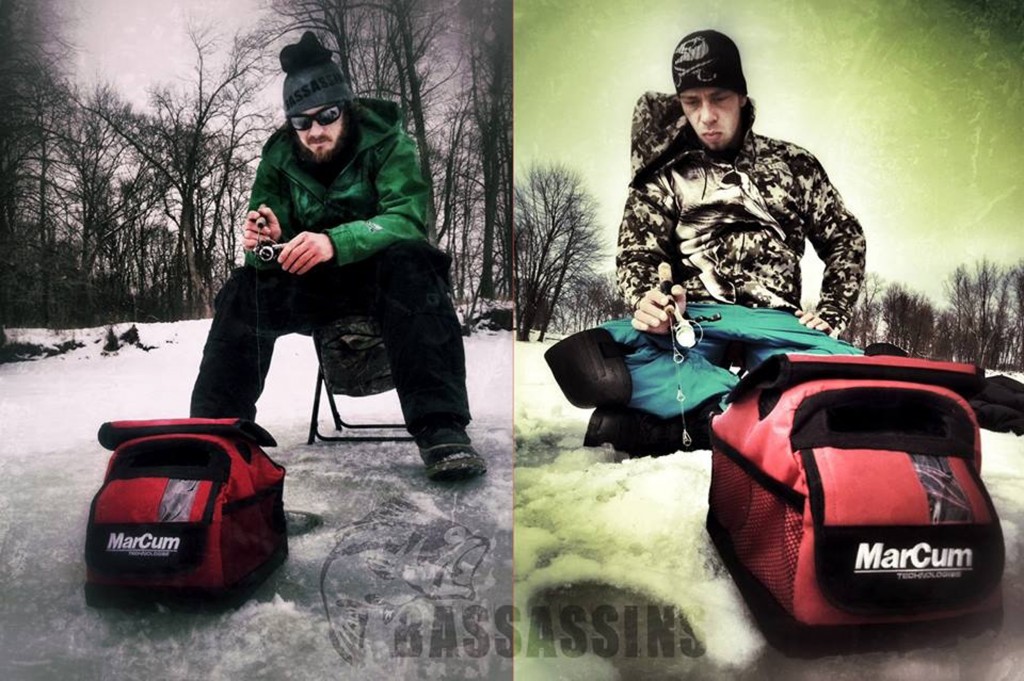
How to:
For an optimum presentation the rule of thumb is to be 1 or 2 feet off bottom. If there are a lot of weeds make sure to be at least a foot above those too. Most predators look up and a suspended bait will be easier for a fish to identify and attack.
Knowing how deep you are is crucial. We use our flashers to find the optimum spot and depth. There is nothing worse than lowering your bait into mud and weeds only to pull it up later in the day covered in green like a Christmas tree; fancy but useless. Once the desired depth is found we like to mark the line with a colored sharpie or such, this will make resetting the trap a breeze later on. After every fight the line should be spooled back in a neatly fashion as messy loops could potentially block the line at some point and will result in tragedy.
Baiting the rig is easy. Attach the last treble to the base of the tail and the second treble in to the back, slightly closer to the head to balance the bait properly. Using one point only and just tucking it under the skin will make the bait come off easily during the fight and sets the stage for a clean hook removal.
Now gently lower it down the hole towards the bottom. Once it’s at the desired depth, set the trigger. Attaching a bell to the flag will ensure you never miss a bite and being able to observe your traps from the get go is a crucial factor to success.
The waiting game begins and in the mean time we will always be actively fishing the area for perch, crappie, walleye or lake trout. Keeping schools of panfish busy nearby is not just fun but often attracts larger predators also.
It’s a good idea to frequently slush the trap holes to prevent them from freezing over. There is nothing worse than a trophy pike spooling off line and your tip up is frozen solid to the hole.
All over sudden, there it is: Ding-ding and a flag is up!
Excitement levels are high but it is important to not just storm over and start yanking the line. Stay cool, calm, and collected.
Grab your pliers, camera and quietly walk over. Even though the flag is triggered, it doesn’t mean we got a pot of gold quite yet. Loud stomping could spook the perp. and he might drop the loot and take off, leaving both parties empty-handed.
A pike generally T-bones the bait and retreats to a better spot where he can turn it around and starts swallowing. A little patience will increase the odds of a secure hook set.
When the fish takes off again, the little pin on top of the spool starts to turn again. If it doesn’t it means either one of two things: There is no fish or most likely the pike has stopped to get a better hold of its prey. This can be nerve wracking but one must wait till the pin goes again. If you set the hook right now, chances are you will rip it right out of its toothy embrace.
Alright, if everything goes according to plan we have some action and line is peeling, lift the tip up out, place it away from the hole while grabbing the line with your other hand. A sharp jerk will set the hook just right. Fighting a big northern on a hand-line in shallow water is tremendous fun but must be executed with some caution.
Oftentimes the pike will just come alongside and all you feel is its weight, but be prepared for its explosive long runs. When he takes off, let him go. Your hands are the drag. Adjusting the pressure on the line with your fingers should ensure that there is always just enough contact to the fish and never any slack.
Laying the gained line on the ice should be done with care to prevent messy knots.
The last challenge is to guide the head through the hole but I find hand-lining gives you great control over this issue. Care should be exercised that no hooks get stuck on the edges.
And that’s it. Pliers and the livewell should make unhooking process a breeze; a quick picture and it’s time for the release.
Bait and set the trap again. Wait, fight, release, repeat.
Whoever is lucky enough to be able to enjoy safe ice this time of the year is in for a real treat. Late season ice can bring some of the best fishing opportunities of the year. Mild temperatures make the experience a lot more fun and the big guys are out on the hunt, hungry and feisty.
So next time, tip up the scale for the big boys.
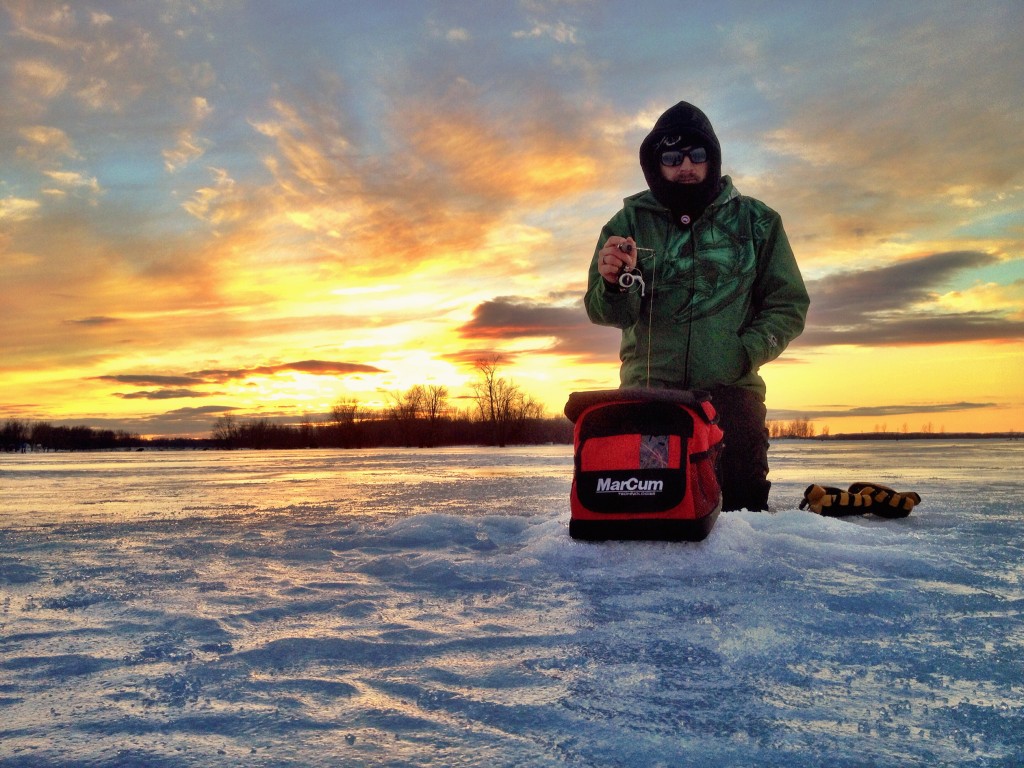
![]()
About The Bassassins

Our names are Robert Fuchs (Basstard – age 30) and Robert Conley (Smooth – age 31) and we are the Bassassins. We are VERY dedicated and talented anglers combining many different skills to wade the rivers, brave the ice and motor our tinny in and around Ottawa, Ontario. With our GoPro and iPhone always in hand we are on the hunt to bring you the biggest and meanest fish species Ontario has to offer.




